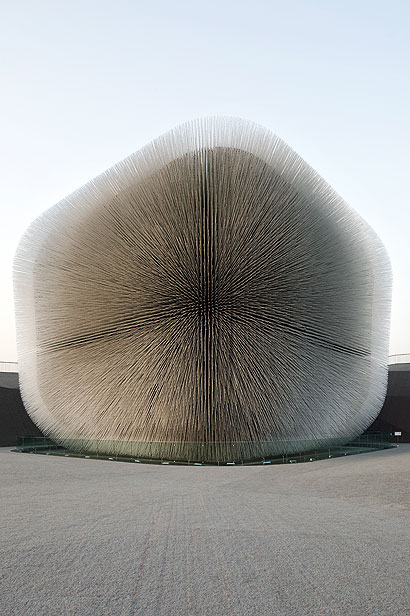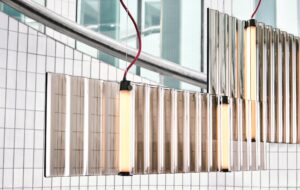|
This amazing, costly architectural theme park is great fun, but does it have any lasting value? Julian Worral finds out One image is ubiquitous on the construction hoardings, billboards and plastic shopping bags in Shanghai these days – the tiered silhouette of the China Pavilion at the Expo 2010. These images, along with the Expo’s theme and slogan “Better City, Better Life”, are touting what is probably the biggest official event in Shanghai since the Cultural Revolution 40 years ago. The numbers are astounding: an estimated cost of $58bn (£38bn), double Beijing’s expenditure on the Olympics and enough money to build a forest of 40 Burj Khalifas. A 5.3sq km site, twice the size of Monaco. An anticipated average attendance of 400,000 people per day. That means over 8,000 portaloos on site. Given the enormous investment, one might ask what is the point of it all? For all their anachronism and irrational exuberance, Expos crystallise a certain official zeitgeist, providing a snapshot of both architecture and geopolitics at a particular moment in history. The monumental face-off between the bombastic German and Soviet pavilions in the 1937 Paris Expo captured with ominous clarity the clash of totalitarian ideologies and the spectre of imminent war. As is often observed in the case of the Olympics, Expos can be milestones in a nation’s development, and can leave enduring legacies for their host cities. If Paris’ Eiffel Tower is an Expo legacy, in Shanghai’s case it will be the addition of 210km of track to the Metro system in the past year – making it the most extensive in the world. Not least, Expo pavilions have written many pages in the history of architecture, from the original Crystal Palace of 1851 to Le Corbusier’s Philips Pavilion in Brussels in 1958. Not to mention Mies van der Rohe’s immortal German Pavilion at the Barcelona Expo in 1929. What pages will Shanghai 2010 write in the history of architecture? Among the clamour of 42 attention-seeking national pavilions, three in particular stood out as saying something about architecture, and one about politics. Clearly outshining the rest, by force of its sheer magnetic attraction, is the British pavilion. A soft spiny box consisting of 60,000 acrylic rods each 7.5m long and set upon a crumpled elevated platform of soft grey turf, Heatherwick Studio’s Seed Cathedral is an extraordinary object, defying both eye and camera. Quietly impassive yet possessed of a shimmering animation with each gust of wind, it astounds because it so effectively resists any attempts at classification – massive or vaporous? Natural or artificial? Virtual or real? Seeds from the Royal Botannical Gardens at Kew and its Millennium Seed Bank – one of which, you might imagine, could have grown into the pavilion itself – are encased in the tip of each rod, inside the building. The resulting interior is a luminous vault that feels both high-tech and organic, and evokes the wonder of both. The lure of the object is irrepressible – during the opening weekend, the line for entry to the pavilion exceeded four hours. Bjarke Ingels Group’s Danish pavilion takes the line of visitor flow and performs a spatial knot with it. The continuity of the path is underscored by the ecologically correct conceit that the pavilion is best experienced by bike (just like Copenhagen, goes the line). The path of flow, which starts as an enclosed passage, follows a rising spiral until it breaks outside at a local peak, then descends and loops back down underneath the enclosed pathway, before rising again to ascend to the enclosed pathway’s roof. The circulation is a mind-bending conundrum, yet concisely resolved. At the centre of the whorl is the Little Mermaid, airlifted from its site in Copenhagen harbour into a cool blue pond of Baltic seawater at the centre of the pavilion. She is the focal point around which the spiraling paths revolve, visually and symbolically. The little bronze statue in its pool of water is an inescapable echo of a similar manoeuvre in another Expo pavilion, that of Mies van der Rohe. The flowing, continuous spatiality, the interpenetration of interior and exterior spaces, the purification of the forms, all conspire to reinforce the allusions to this icon of modernism. The fact that this is an organic, curvilinear space, not a disciplined rectilinear one, does not diminish the implication that BIG has attempted an extension of modernist spatial aesthetics to an era enamoured of voluptuous organic forms, and is not shy of claiming such a historical pedigree. In contrast to the elegant formal and spatial manoeuvres of these two pavilions, the Netherlands’ contribution is an undisciplined riot, the product of the rampant imagination of John Körmeling. Bearing the disarming name Happy Street, the pavilion consists of a winding red path lazily climbing its way above the site, about which are propped on stilts an assortment of houses drawn from a parade of Dutch architectural history, from Amsterdam canal houses to modernist icons such as Rietveld’s Schröder House. Each house has been given over to a representative of Dutch contemporary culture and innovation – from the designs of Maarten Baas and Hella Jongerius to technology for purifying stormwater runoff. But the real essence of the pavilion is to be found at ground level, where Körmeling has laid a field of green Astroturf populated by sheep cast in fibreglass. This proved to be a hit with the locals, providing the priceless spectacle of entire Chinese families gathered in the shade on the fake grass, using clutches of sheep as furniture. These three pavilions can be seen as being the most eloquent representatives of three positions within the contemporary architectural conversation. Heatherwick’s dandelion is the magical object, an assertion of the power of the design to produce objects of enchantment and disbelief. BIG’s pavilion presents a spatial diagram of lucid complexity that positions itself within the modernist history of architectural space. And Körmeling’s effort offers the magnanimity and inclusiveness of public space, bringing the Chinese a taste of the freewheeling culture of tolerance that until recently was the Netherlands’ proudest achievement. Despite all this foreign architectural ambition, the most popular pavilion is thoroughly home-grown – the Chinese pavilion. Vast and overbearing, resembling a magnified temple bracket, daily tickets to this pavilion seem to be permanently sold out. While the Expo promotes the idea of experiencing the world through a vicarious experience of travel (visitors are given “passports” to be stamped at the exit of each pavilion), its most significant achievement will likely be the reflection it offers of China to herself at a peak of national self-confidence.
The Expo is being held on the banks of the Huangpu river until 31 October 2010. en.expo2010.cn |
Image Inigo Bujedo Aguirre
Words Julian Worrall |
|
|

















